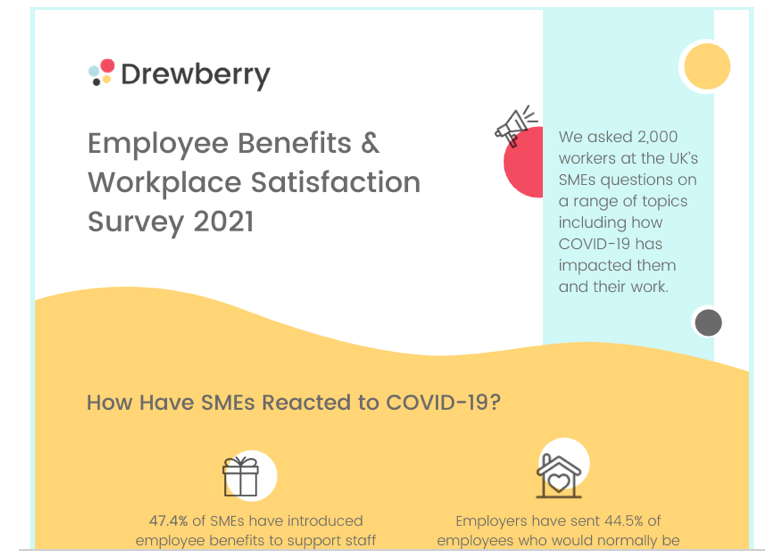The 2021 Drewberry™ Employee Benefits & Workplace Satisfaction Survey
Welcome to the Drewberry™ Employee Benefits & Workplace Satisfaction Survey 2021. This is our second Employee Benefits survey — and the landscape has shifted significantly since the last edition in 2019/20.
2020 was an incredibly difficult year for everyone, dominated as it was by COVID-19. It was therefore impossible to put together a survey of workers in small- and medium-sized enterprises (SMEs) without mentioning the impact of the pandemic.
Despite this, we’ve kept many of the same questions as last time, which serve as important benchmarks as to just how much things have changed over the past year.
In total, we asked 2,000 workers at the UK’s SMEs questions on a range of topics, including:
- How happy they are in their job (and what influences workers if they’re looking for a new role)
- What employers can do to improve worker happiness in the workplace (including the top workplace benefits employees would like to see)
- Levels of workplace stress
- Job satisfaction
- The impact of coronavirus on mental health, productivity and more.
Research Summary
- More workers want their employers to offer insurance benefits. The policies which saw the biggest increase in demand were Group Critical Illness Cover and Group Life Insurance.
- Employers have responded to this growing demand — 47.4% of SMEs have introduced new employee benefits since the start of the pandemic. Here are 10 benefits you might want to introduce so you don’t miss out on this trend.
- There was a big drop (of 19.5 percentage points) in the percentage of people seeking a new job in the next 12 months.
- Notable increase in mental health, work and physical health as the main causes of stress.
- Employee contentment with their work / life balance has improved since the last survey. It is now the second-most important factor in terms of what makes staff happy.
- 44.5% of office workers now work from home and are seeing a self-reported productivity increase. 31.7% feel they’re more productive at home and 18% feel they’re far more productive.
- Meanwhile, 39.3% of workers said their mental health had improved since shifting to home working.

Top Stories From Our Survey
- Rising Demand for Employee Benefits: What Your Staff Really Want…
- Almost Half of SMEs Overhaul Their Employee Benefits Due to COVID…
- Employee Productivity: The Truth Behind the Remote Working Shift…
- New Inequality: Women Face Worse Pandemic Home Working Experience Than Men…
- Almost 3 in 5 SME Workers Say They Regularly Feel Stressed…
- What Do Your Workers Want From a Post-Pandemic World?
- What Workers Want the Most From a New Role in 2021…
How Has COVID-19 Impacted Businesses & Their Employees?
How Companies Have Responded | |
|---|---|
🎁
47.4% of SMEs have introduced employee benefits to support staff since the COVID-19 outbreak.
| 🏘️
44.5% of employees are now permitted to work from home.
|
How Workers Have Responded to COVID-19 | |
|---|---|
⛅
39.3% of workers said their mental health had improved since they’d started working from home.
| ⛈️
However, 21.9% said their mental health had got worse or much worse as a result.
|
💔
When those whose mental health has worsened since working from home were asked why, 69.7% said it was due to a lack of social interaction.
| 🙍
63.6% of workers said their mental health had declined since working from home due to feeling isolated, while 35.4% said it was due to difficulties with work / life balance.
|
🐝
49.7% of workers said they’d either become more productive or far more productive since working from home, while 36.1% said their productivity had stayed the same.
| 🚫
The main challenge workers face working at home are feeling less connected to colleagues and the organisation and difficulties communicating with fellow workers.
|
SMEs Face Rise In Demand for Benefits from Staff | |
|---|---|
🏥
30.7% of workers want Group Critical Illness Insurance, a percentage rate increase of 38.9%.
| 💀
33% of workers want Death in Service Insurance, a percentage rate increase of 13.8%.
|
👩⚕️
35.3% of workers want Group Private Health Insurance, a percentage rate increase of 12.8%.
| 🤕
27% of workers want Group Income Protection Insurance, a percentage rate increase of 17.2%.
|
🕐
46.2% of workers want their employer to introduce flexible hours, a percentage rate increase of 20%.
| 💰
30.5% of workers want their employer to introduce home working, with 18.7% saying they’d like an expense allowance for it.
|
What Else Do Your Workers Want in a Post-Pandemic World? | |
|---|---|
💷
When looking for a new job, 61.7% of workers said salary was a big factor.
| ⌚
Working hours were a main factor for 54.9% of SME staff members when they were looking for a new job.
|
📍
Location was a major factor for 54.4% of people when they were seeking a new job.
| 🏃♀️
51.1% of workers said they’d like to see their company introduce benefits that support their health and wellbeing.
|
📚
46.4% of staff want to see their employer offer training, or benefits that help them work toward their career goals.
| 🎟️
40.4% of workers would like employers to offer gifts and rewards they can use outside of work, e.g. employee discounts or event tickets.
|
🏙️
45.7% of workers said they were either fairly keen or very keen to return to their workplace.
| 📅
However, they don’t want to do so full-time — just 13.5% wanted to go back to 5 full days in the office.
|
Certain Causes of Stress Rise Considerably | |
|---|---|
📈
There was an increase in the proportion of workers who reported being stressed in 2020.
| 🏡
However, the rise wasn’t as much as expected. With 44.5% of office workers now working from home, this could have reduced stress.
|
🌧️
There was a 22.5 percentage point increase in workers saying their mental health causes them stress.
| 💻
Meanwhile, work stressed out 61.7% of employees, up by 17.8 percentage points on last time.
|
🤒
Perhaps unsurprisingly given the COVID-19 pandemic, the percentage of staff saying their physical health causes them stress rose by 12.7 percentage points, to 26.5%.
| |
Satisfaction With Work / Life Balance Up | |
|---|---|
⬇️
Sharp decrease in people seeking a new job in the next 12 months (down 19.5 percentage points).
| 😃
62.3% of workers somewhat happy or very happy in their current job.
|
😊
51.6% of workers said their colleagues were what made them happy at work.
| ⚖️
Work / Life balance rises to second-most important factor keeping employees happy at work, up from 4th previously.
|
😔
For those unhappy at work, 48.8% of respondents said it was due to a lack of recognition for their efforts.
| 👨💼
Similarly, a lack of general support from managers / coworkers caused workplace unhappiness for 40.3% of workers.
|
All Our 2021 Worker and Employee Benefits Statistics in Detail…
To delve deeper into the statistics from our 2021 Employee Benefits & Worker Satisfaction survey, take a read through the major topics and look at the graphs below.
How Have Workers Managed at Home During the Pandemic?
The arrival of coronavirus in the spring of 2020 and the associated lockdowns changed the country’s way of working almost overnight. Office workers swapped their desks for kitchen tables or any flat surface they could find and commuting was put on hold.
Mental Health and Working from Home During COVID-19
39.3% of workers said their mental health had got much better or a bit better since working from home due to the outbreak of the coronavirus pandemic. However, 21.9% said it had got worse or much worse.
- Lack of social interaction (69.7%)
- Feelings of isolation (63.6%)
- Difficulties managing work / life balance at home (35.4%).
Productivity for Those Working at Home Due to COVID-19
Almost half (49.7%) of workers said they had either got more productive or far more productive since working from home. A further 36.1% said it had remained about the same.
What Challenges Have Home Workers Faced?
The main challenges workers have faced while working from home include:
- Feeling less connected to colleagues and the organisation (37.1%)
- Difficulties communicating with colleagues (33.9%)
- Distractions from family members (32.3%).
Rise in Staff Seeking Insurance and Other Employee Benefits
There was an increase in the percentage of workers seeking all four main insurance policies when it came to employee benefits. Workers wanted their companies to introduce:
- Company Private Medical Insurance (35.3%, a percentage rate increase of 12.9%)
- Death in Service Insurance / Group Life Cover (a percentage rate increase of 13.8%)
- Group Critical Illness Cover (30.7%, a percentage rate increase of 38.9%)
- Group Income Protection (27%, a percentage rate increase of 17.2%).
Other popular benefits workers wanted their employers to introduce include:
- Flexible hours (42.3%, a percentage rate increase of 29%)
- Work from home options (33.6%, a percentage rate increase of 14.9%)
- Additional employer workplace pension contributions (21.5%, a percentage rate increase of 31.5%).
However, the benefit that saw the highest rise in demand over this period was remote GP services. 13.5% of workers wanted to see their employer introduce this as a benefit, a massive percentage rate increase of 264.2% compared to previously.
Many of the above, popular employee benefits offer a virtual GP service as an additional benefit alongside the policy. Check out our director’s experience using one such service here.
Which Types of Employee Benefits Do Workers Find the Most Attractive?
The top three types of employee benefits workers would most like to see were:
- Those which help them manage their health and wellbeing, such as Private Medical Insurance or the various additional benefits that come with group protection (51.1%)
- Benefits that train or educate them in areas relevant to their career goals (46.4%)
- Rewards and gifts that can be used outside of work, such as retail discounts or event tickets, another area often provided by protection policies as additional benefits (40.4%)
- Provide staff with workplace financial education to relieve stress and help them improve their financial wellbeing (36.9%)
What Does an Ideal Post-Pandemic Future Look Like for Staff?
With so much changing so fast as a result of the coronavirus outbreak, it’s unlikely things will ever return to the way they were previously. Workers have new goals, needs and desires to meet — here’s what they want from their post-pandemic working life.
Will Workers Want to Go Back to the Office?
While the main opinion was for heading back to the office, with 17.9% saying they were very keen to go back to the office and 27.9% saying they were fairly keen to do so, this wasn’t a majority of people.
For Happy Workers, Employers Should Adopt Hybrid Working
Just 13.5% of workers said they were keen to return to the office full-time, 5 days a week. The most popular option workers chose was 3 days in the office and 2 days working from home.
What Are Employees Looking for When Seeking New Roles?
The usual suspects featured in terms of what employees want from a new role. 61.7% said salary was important, while 54.9% said working hours and 54.4% said location.
However, in terms of importance salary dipped by 5.3 percentage points, working hours by 4.7 percentage points and location by 2.4 percentage points.
What rose notably in importance was job security (with 35.8% saying this was important, up by 6.8 percentage points). This suggests the pandemic and economic downturn has resulted in workers being willing to sacrifice certain aspects of any future role for a company that will offer them security.
Worker Happiness
63.3% of workers said they were happy at work, down marginally from 67.6% previously but not a huge dip in overall worker satisfaction given the year we’ve had.
For those who said they were happy at work, the main causes of workplace satisfaction were:
- Colleagues (51.6%)
- Work / life balance (49%)
- The challenging and stimulating nature of their role (33.5%).
What Caused Workplace Tension in 2020?
For those who weren’t happy at work, the main causes of unhappiness were:
- Lack of recognition for their efforts (48.8%)
- Feeling underpaid (40.7%)
- Lack of general support from managers / coworkers (40.3%).
While it may be difficult to offer employees an across the board payrise given the year we’ve just had, what may be a more affordable way of making employees feel recognised for their efforts is an effective employee benefits program.
With premiums for a policy such as Group Life Insurance being both tax-deductible and cheaper than many may realise, it’s an excellent first step into the world of benefits.
That’s why thriving financial services firm Profile Pensions introduced their scheme — read more about it here.
Stress and the Workplace
Despite a very difficult year, the percentage of people who admitted to regularly feeling stressed increased by just 3.3 percentage points. The latest data indicates that 58.3% of workers strongly agree or somewhat agree to regularly feeling stressed.
What Causes Workers Stress?
The main causes of stress were:
- Work (61.7%, up by 17.8 percentage points)
- Mental health (38.5%, up by 22.5 percentage points)
- Physical health (26.5%, up by 12.7 percentage points).
What Can Employers Do About Stress?
Not only are mental health concerns high on the list, but there’s been a notable increase in these as a cause of stress from our previous survey. As a nation, the worry is that we’re sitting on a mental health time bomb.
This comes at a time when NHS resources are understandably highly stretched coping with the physical health fallout from the pandemic. This leaves little room for mental health.
Staff could face a terrible mental health burden, while employers bear the economic impact of workplace absence due to stress, depression, anxiety and more.
Fortunately, it’s an area that employee benefits can offer assistance with. Many group protection policies come with some form of counselling service, or at least free mental health resources for workers to use.
Meanwhile, Group Health Insurance can include psychiatric care as an optional extra — ask an adviser about the benefits of adding this to your policy.
Share Our Survey Results
Contact Us
85 Queen Victoria Street
London
EC4V 4AB
125-135 Preston Road
Brighton
BN1 6AF
Cookies
Drewberry™ uses cookies to offer you the best experience online. By continuing to use our website you agree to the use of cookies including for ad personalization.
If you would like to know more about cookies and how to manage them please view our privacy & cookie policy.









